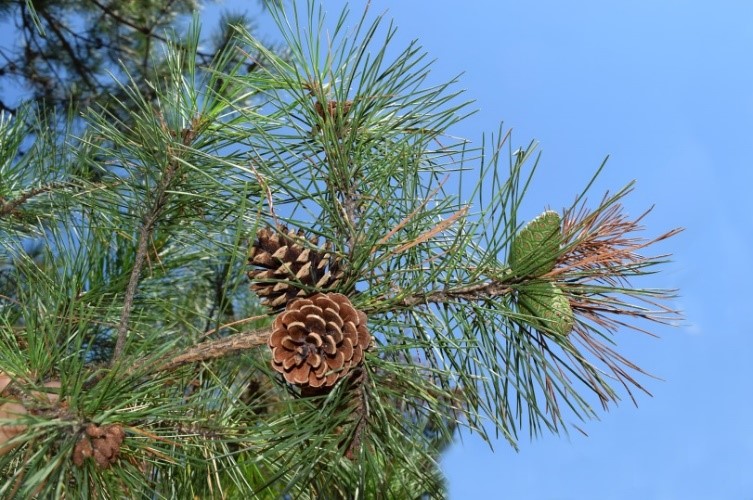NEW JERSEY FOREST SERVICE ENCOURAGES LANDOWNERS TO HELP
SPREAD SHORTLEAF PINE TREES ACROSS PINELANDS REGION
(18/P064) TRENTON – As a partner in a multistate initiative, the Department of Environmental Protection is encouraging landowners in the Pinelands to use technical assistance and expertise available through the New Jersey Forest Service to help restore shortleaf pine trees to the region.
 The Forest Service is a partner in the Shortleaf Pine Initiative comprising 22 states, federal forestry and wildlife organizations, and other partners. The New Jersey Forest Service offers technical and other assistance to help landowners incorporate the species into their forest management plans.
The Forest Service is a partner in the Shortleaf Pine Initiative comprising 22 states, federal forestry and wildlife organizations, and other partners. The New Jersey Forest Service offers technical and other assistance to help landowners incorporate the species into their forest management plans.
“New Jersey’s Pinelands is globally recognized for unique ecosystems that support a wide variety of plants and animals, some found in few places outside this region,” Commissioner Catherine R. McCabe said. “While the pitch pine is the predominant tree species in the Pinelands, re-establishing shortleaf pine helps restore a species that once had a bigger presence in the region and create opportunities for greater wildlife diversity.”
The shortleaf pine (Pinus echinata) is found in the eastern and southern U.S. and as far west as Texas and Oklahoma. New Jersey and parts of Pennsylvania represent the northernmost extent of its range. In the Pinelands, the species prefers drier upland habitats. It is one of many species the Forest Service is working to restore across the state.
 Shortleaf pine has declined across much of its range due to insect damage, disease, competition from other species, inadequate forest management practices in the past and changes in land use patterns.
Shortleaf pine has declined across much of its range due to insect damage, disease, competition from other species, inadequate forest management practices in the past and changes in land use patterns.
New Jersey has more than 400,000 acres of pine forests in the Pinelands region. The shortleaf pine represents only about two percent of the total.
Nevertheless, attendees at a national conference on shortleaf pine restoration held last fall at Stockton State University were amazed at New Jersey’s existing shortleaf pine resource and the potential to grow its population.
“In New Jersey, private landowners own 47 percent of forested land,” State Forester John Sacco said. “They can make a big difference in restoring this species. We encourage them to learn about this program and to take advantage of the technical resources we offer. Properly managed forests help to capture greenhouse gases that contribute to global warming.”
 Participation in the state’s Forest Stewardship Program offers several benefits, including formal recognition for environmentally responsible management, financial management assistance and the personal satisfaction for being stewards of their land. To be eligible, property owners must manage at least five acres of forest.
Participation in the state’s Forest Stewardship Program offers several benefits, including formal recognition for environmentally responsible management, financial management assistance and the personal satisfaction for being stewards of their land. To be eligible, property owners must manage at least five acres of forest.
The Division of Parks and Forestry has launched initiatives to establish or enhance shortleaf pine in Wharton and Brendan T. Byrne state forests in the Pinelands. The division hopes to expand the total acreage of shortleaf pines on state and private lands by 30,000 acres during the next 10 years.
Landowners interested in managing shortleaf pine on their properties and funding assistance opportunities may contact Forest Service Supervising Forester Jon Klischies at (609) 984-0827. They may also contact a state-approved forester. For a list, visit www.nj.gov/dep/parksandforests/forest/ACF.pdf
 Shortleaf pines have experienced a 50 percent decline in its range over the past 30 years, with the most significant declines occurring east of the Mississippi River.
Shortleaf pines have experienced a 50 percent decline in its range over the past 30 years, with the most significant declines occurring east of the Mississippi River.
The Shortleaf Pine Initiative, launched in 2013, is a coalition of states within the species’ range and includes the U.S. Forest Service, U.S. Fish and Wildlife Service, The Nature Conservancy, the National Fish and Wildlife Association, the Southern Group of State Foresters and other state and regional forestry groups.
In 2016, the initiative launched a five-year plan to stem the rapid loss of the species and to improve shortleaf pine ecosystems across its range. Well-managed shortleaf pine forests can provide habitat for wildlife species such as grassland birds and woodpeckers. To learn more about the Shortleaf Pine Initiative, click the logo above or visit www.shortleafpine.net/
In addition, the New Jersey Forest Service Nursery in Jackson Township, Ocean County, sells shortleaf pine seedlings as well as 25 other evergreen, deciduous tree and shrub seedling species. The nursery will accept orders for seedlings starting in December for delivery and planting the following spring. To order shortleaf pine and other seedlings, visit www.forestnursery.nj.gov
For information on grants for conservation planning, which is critical for implementing forestry practices, visit the U.S. Natural Resources Conservation Service Environmental Quality Incentives Program at www.nrcs.usda.gov/wps/portal/nrcs/main/nj/programs/financial/eqip/
To like New Jersey Forest Service on Facebook, visit: www.facebook.com/newjerseyforests
For information about the New Jersey Forest Service, visit: www.forestry.nj.gov
Follow the DEP on Twitter @NewJerseyDEP
###